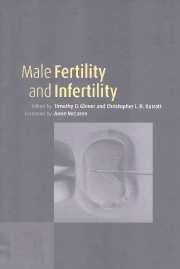Book contents
- Frontmatter
- Contents
- List of contributors
- Foreword by Anne McLaren, FRS
- Preface
- Acknowledgements
- Part 1 Biological perspectives
- 1 The evolution of the sexual arena
- 2 The role of sperm competition in reproduction
- 3 Sperm production and delivery in mammals, including man
- 4 The local control of spermatogenesis
- 5 Some misconceptions of the human epididymis
- 6 Transport of spermatozoa to the egg and fertilization success
- 7 Changes in human male reproductive health
- Part 2 Implications of the new technologies
- Index
3 - Sperm production and delivery in mammals, including man
from Part 1 - Biological perspectives
Published online by Cambridge University Press: 09 August 2009
- Frontmatter
- Contents
- List of contributors
- Foreword by Anne McLaren, FRS
- Preface
- Acknowledgements
- Part 1 Biological perspectives
- 1 The evolution of the sexual arena
- 2 The role of sperm competition in reproduction
- 3 Sperm production and delivery in mammals, including man
- 4 The local control of spermatogenesis
- 5 Some misconceptions of the human epididymis
- 6 Transport of spermatozoa to the egg and fertilization success
- 7 Changes in human male reproductive health
- Part 2 Implications of the new technologies
- Index
Summary
Introduction
At a time of rapid technological advance such as we have seen over the past few years in the field of human reproduction, the basic principles of mammalian male reproductive biology can easily be obscured or over-looked. Chapter 3 has been written with this in mind and is intended to be a simple reminder of fundamentals.
The function of a spermatozoon is to deposit a haploid set of chromosomes in the cytoplasm of the oocyte and to contribute to the first cleavage division. To enable it to do this, it is produced from a diploid gonium with enough cytoplasmic components to propel it for a limited distance and to survive its passage from the testis to the site of fertilization. It also contains pro-enzymes which, in the presence of an oocyte, are activated to prepare the spermatozoon for penetration of the zona pellucida, passage through the vitelline membrane and entry into the ooplasm.
The production and delivery of the spermatozoon is the sole biological raison d'être of the male mammal. Production is the province of the testis, whilst delivery involves the epididymis, seminal emission, an ejaculatory reflex (following penile erection) and coordination of the rest of the body with external events. These processes together constitute male sexual behaviour.
The effect of mammalian male sexual behaviour is to deposit semen in a suitable part of the female tract at a time propitious for the spermatozoa to reach the site of fertilization and fertilize an oocyte.
- Type
- Chapter
- Information
- Male Fertility and Infertility , pp. 34 - 55Publisher: Cambridge University PressPrint publication year: 1999
- 1
- Cited by



